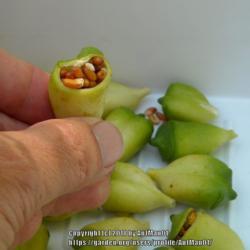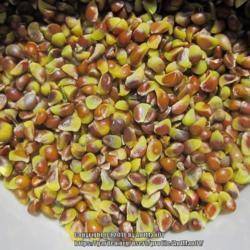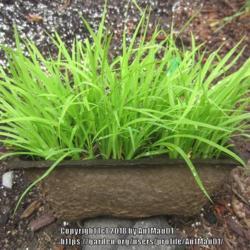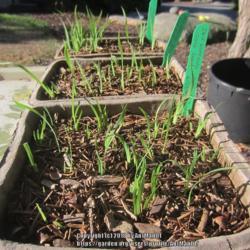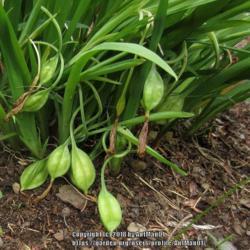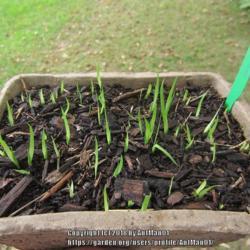As Rick mentioned, many spring blooming "ephemerals" have seed that must be sown shortly after ripening. A common feature of ephemeral seed is the presence of an elaiosome, a fleshy structure that attracts ants to carry away seed to their nests, the ants eat the elaiosome portion leaving the seed to possibly germinate. Some ant-dissemated seed include Jeffersonia, woodland Iris species, Epimedium, Trillium, many others.
https://en.wikipedia.org/wiki/...
All such seed is best to sow soon after harvest. Studies have shown that Jeffersonia seed needs to be sown promptly after ripening, then the seed flats go through a summer/fall phase of warmth, followed by a period of winter cold stratification, the seeds germinate freely the following spring. Epimedium seed is classic in this same requirement, so I sow all of my Epimedium hybrid seed in June after harvesting, they're planted in pressed fiber flats and left sitting in contact with the ground under the shade of trees; the fiber pots "breathe" and wick moisture, keeping moisture levels moderated. I lightly water the flats only in very hot dry periods, then they're left outside all winter, they germinate like beans in the spring. Note: all flats are covered with wire mesh to keep out chipmunks and squirrel digging.
I'm passionate about this subject, so allow me to share some examples:
Our native Jeffersonia diphylla, pods turning yellowish, the pod "caps" starting to unhinge to release seed, notice the white elaiosomes attached to the seed.
Jeffersonia diphylla seed, not allowed to dry out, can keep in plastic bag for up to 2 weeks
Jeffersonia seed in back row, I add dry vermiculite to the bags to absorb some of the moisture from the seeds and elaiosomes), bag of Iris koreana seed in the front, more about that one below.

Sowing seed of Jeffersonia (I think it's J. dubia seed), at its bagged storage limit where the seed has gotten very moist and sticky. I have always wondered what types of seed can be stored moist for long term, I noticed NARGS has moist-pack seed in the seedex; with Epimedium and Jeffersonia they rot if kept much more than 2 weeks.

In spring, seeds of Jeffersonia dubia and diphylla "come up like beans",

Top left is J. dubia, the other two flats are J. diphylla.
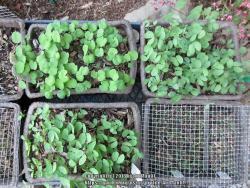
Seed of Iris gracilipes, among the most beautiful woodland Iris, the seeds are beautiful too. Seed matures early to mid July, need to watch closely because pods give no indication when they're ready, all pods shed in one day.
Seedlings of Iris gracilipes one year later, always get near 100% germination.
Seed harvest on our native Crested Iris, I. cristata 'Shenandoah Sky', seed ripens very late on this selection, at the end of August. Notice the familiar elaiosomes attached to seeds. Same seed sowing treatment.
Seed pod on woodland Iris from Korea, Iris koreana, split open to see if seed is mature enough, it's ready in this photo. These pods give no indication when they're ripe, when it approaches mid June I break open a pod here and there to check. If one waits too long, all the seed will shed in one day.
Seed harvest on Iris koreana in 2016, a good year. This species is very shy with seed, most pods are not fertile, something bores into the pods and eats the developing seed, so I take advantage of the bumper-crop years. I think the seeds are beautiful, the white elaiosomes prominent in this species.
Very interesting thing about Iris koreana (and a sibling Korean species Iris odeasanensis, see below) is that they are "warm germinators". I sow seed immediately when ripe (2nd-3rd week of June), get germination in 6 weeks at beginning of August. In another 6 weeks, mid September, seedlings are big enough to plant outside and overwinter just fine. Here's Iris koreana seedlings mid September 2016.
Pods of Iris odaesanensis (also from Korea) are triangular shaped affairs on coiling stems half-hidden amongst the mats of foliage.
Iris odaesanensis germination at beginning of August, just 6 weeks after sowing.
Iris odaesanensis seedlings in mid-September, just 6 weeks after germination, ready to plant out to settle in and overwinter. I've had no overwintering losses planting out these youngsters in autumn.
